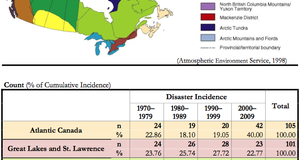From Earth Common Journal VOL. 6 NO. 1Sweden, the World's Most Sustainable Country: Political Statements and Goals for a Sustainable Society
By
Earth Common Journal 2016, Vol. 6 No. 1 | pg. 1/1
IN THIS ARTICLE
KEYWORDS
AbstractSweden, a small country with almost 10 million inhabitants, is the world's most sustainable country according to some reports that compare environmental, social, and governance components between nations. Sweden plays a significant role in the European Union's work for a sustainable society in the European Union. Strict environmental policies and governmental initiatives that encourage all members of the society to invest in climate change projects are among the reasons that put Sweden on top of sustainable ranking lists. During the 2015 United Nations Climate Change Conference in Paris, a number of goals were agreed upon and formalized as the Paris Agreement. One important aspect of the Paris Agreement is that there has to be collaboration between nations in the work against global warming. Sweden is already taking steps to achieve many of the goals set out in the 2015 UN Climate Conference as its government has established robust environmental policies. One such agency, Naturvårdsverket (the Swedish Environmental Protection Agency), is responsible for monitoring the state of the environment. Naturvårdsverket's work is largely influenced by Sweden's national environmental objectives. One generational goal, sixteen environmental quality objectives and 24 milestone targets define the direction of environmental work in Sweden, within the EU, and internationally. It is with frameworks like the national environmental objectives and governmental initiatives that encourage members of the society to actively participate in the work for climate change, that the Swedish government develops and implements its environmental policy. IntroductionHow often have you heard the argument "I recycle, but there are far too many who don't, and therefore it makes no sense that I do it, either?" This is a common way of thinking because it can be difficult for individuals to see the larger scale impact of small acts. But, if everyone thinks this way, then nothing will ever change. One cannot do everything but with a little effort from everyone, we can make meaningful change. If all nations actively take part in the work against global warming, we may also be able to keep our planet. Sustainable SwedenSweden is a small country with almost 10 million inhabitants (Swedish Institute, 2015a, para. 1). This small nation cannot, regardless of how sustainable it is, save the planet by itself. But, as a welfare country on the front edge in the international work for climate change, Sweden has a greatly influential role internationally in the work for sustainability and work against global warming; Sweden's official site speaks to this: Sweden ranks first in the European Union (EU) in consumption of organic foods, leads the way in recycling drinks cans and bottles, and gets the highest share of its energy from renewable sources. What's more, Swedish fashion retailer H&M is a world leader in using organic cotton and the Government has allocated SEK 400 million for research and development of environment technology. (Swedish Institute 2015b, para. 1) According to the 2016 Robecosam Country Sustainability Ranking Update (an updated report based on the 2015 Robecosam Measuring Country Intangibles) Sweden is the most sustainable country in the world (p. 5). This was evaluated on environmental, social and governance components (ESG). Ranking countries according to ESG-scores provides a detailed evaluation of how well countries are responding to the various environmental, social and governance risks they face (p. 7). Among the reasons Sweden got the highest score are strict environmental policies and governmental initiatives that encourage all members in the society to invest in climate change projects. The use of renewable energy sources and the resulting low carbon dioxide emissions are also significant factors in Sweden's sustainability (p. 11). The 2015 Robecosam report also demonstrates that many other western welfare states—a term that refers to a concept of government in which a government is responsible for the social and economic welfare of its people—are highly ranked as well (Robecosam, 2015, p, 3-5). It makes sense then that welfare states collaborate with developing countries as was agreed during the December 2015 United Nations Climate Change Conference in Paris. The conference was a huge step towards international collaboration in the climate work. After the conference, the Swedish Environment Minister during this time, Åsa Romson, wrote in a press release that a global climate agreement is a milestone for the world and for the international collaboration for a sustainable development. Sweden has long pushed for an agreement that will strengthen international climate work. Sweden will continue to show leadership through concrete actions at home in broad cooperation with all social members. We will become the world's first fossil-free welfare country and through our work we will inspire and drive others. (Swedish Government 2015a, para. 2-4) The goals that were agreed on in Paris are listed in the summary of the Paris Agreement from the United Nations Framework Convention of Climate Change. Some of the key aspects are as follows:
Nations participating in the agreement will collaborate with each other (United Nations Framework, 2015, para. 6-18). These are ambitious goals set out in the Paris Agreement, so one can understand why it's crucial that all nations work hard and encourage each other to meet them. In this respect, the rest of the world will look to Sweden and its existing environmentally friendly innovations as well as its well-developed environmental policy. Sweden's robust environmental policy did not come together by chance—it is the result of goals and statements that are laid out by governmental agencies. One such agency, Naturvårdsverket (the Swedish Environmental Protection Agency), is responsible for monitoring the state of the environment and then developing and implementing policy accordingly. Naturvårdsverket's work is largely influenced by Sweden's national environmental objectives. These objectives define the direction of environmental work in Sweden, within the EU, and internationally Naturvårdsverket 2016a, p. 1) These national environmental objectives are organized into three different types: 1 generational goal, 16 environmental quality objectives and 24 milestone targets (Naturvårdsverket 2016c, para. 1). Sweden's generational goal is an "overall goal…to leave a society to the next generation where the major environmental problems have been solved, without causing increased environmental and health problems outside Sweden's borders" (Naturvårdsverket 2016d, para. 1). The generational goal informs the overall direction for Sweden´s environmental policy and guides all members of Swedish society in their efforts to create a more sustainable society within one generation. While creating a more sustainable society in one generation is no easy task, the generational goal has allowed the Swedish government to focus their efforts on a list of objectives—one that includes recovering ecosystems, conserving biodiversity and natural and cultural environments, encouraging more sustainable individual practices and minimizing environment-related health problems (Naturvårdsverket 2016d, p.1). The agency's two other types of environmental objectives—the 16 environmental quality objectives and 24 milestone targets—are designed to make this generational goal more tangible and thereby facilitate progress. Sixteen environmental quality objectives describe the state of the environment that Sweden wishes to achieve by year 2020 (Naturvårdsverket, 2016c, para. 1). For each objective there are a number of specifications that clarify what has to be done to meet the goals. The objectives outlined are:
(Naturvårdsverket, 2015, p.1) The milestone targets in the national environmental objectives define how to reach the generational goal and the environmental quality objectives. Twenty-four milestones have been adopted by the Swedish government within the following areas: reduced climate impact, waste management, biodiversity, hazardous substances and air pollution. These stage goals identify a desired social transformation; they are steps on the way to reach the generational goal and other environmental quality objectives. They show what Sweden as a nation can do and clarify where action should be taken, (Naturvårdsverket, 2016e, para. 1). An important aim for the environmental quality objectives and milestones is that they should guide society's governmental authorities and private actors (Naturvårdsverket, 2016c, p.1). It is with frameworks like the generational goal, the milestones, and the environmental quality objectives, that the Swedish government develops and implements its environmental initiatives. One such initiative, Fossil-free Sweden, aims to make Sweden the first fossil-fuel free nation by year 2050. To reach this goal, the government will actively encourage all members in Swedish society to reduce their emissions. The initiative is beneficial for the environment and also gives recognition to citizens that actively contribute to the protection of our environment (Swedish Government 2015b, para. 1). Another government initiative, Klimatklivet, is managed in collaboration with other central agencies. It aims to encourage members in the society to invest in local based climate projects. Under this program, private actors, such as you and me, can apply for money from the government to execute climate change projects. These projects can be anything from building loading stations in the countryside for electric vehicles to investing in solar panels (Naturvårdsverket, 2016b, para. 1-2.). ConclusionSweden has a well-structured environmental policy with clear goals for climate action both nationwide and internationally. The Swedish government and other organizations and central agencies are able to lead by example and encourage actors in other countries to follow their footsteps. Despite the small size of the country and the small amount of inhabitants, the Swedish way of sustainable living can make a difference in the world. The international agreement in Paris is a huge step towards international collaboration for a sustainable planet—one nation cannot save the planet by itself but together and with goals in common, all nations will take part in the change of the planet's destiny. AuthorMaria Månsson is a graduate of the Bachelor program of Media and Communication at Umeå University in Sweden. During the winter term 2015 Maria studied in the Communication program at Grant McEwan University. She lives in Sweden where she works with public relations and communication in the outdoor field. Maria is both an editor and an author for this years' journal. ReferencesNaturvårdsverket. (2016a). About the Swedish Environmental Protection Agency. Retrieved from http://www.swedishepa.se/About-us/ Naturvårdsverket. (2016b). Klimatklivet – lokala klimatinvesteringar. Retrieved from http://www.naturvardsverket.se/klimatklivet# Naturvårdsverket. (2016c). The environmental objectives system. Retrieved from http://www.swedishepa.se/Environmental-objectives-and-cooperation/Swedens-environmental-objectives/The-environmental-objectives-system/ Naturvårdsverket. (2016d). The generational goal. Retrieved from http://www.swedishepa.se/Environmental-objectives-and-cooperation/Swedens-environmental-objectives/The-generational-goal/ Naturvårdsverket. (2016e). Milestone targets. Retrieved from: http://www.swedishepa.se/Environmental-objectives-and-cooperation/Swedens-environmental-objectives/Milestone-targets/ Naturvårdsverket. (2015). The national environmental quality objectives. Retrieved from http://www.swedishepa.se/Environmental-objectives-and-cooperation/Swedens-environmental-objectives/The-national-environmental-objectives/ Robecosam. (2016) Country Sustainability Ranking Update—May 2016. Retrieved from http://www.robecosam.com/images/Country_Ranking_Update_May_2016.pdf Robecosam. (2015) Measuring Country Intangibles. Retrieved from http://www.robecosam.com/images/Country-Sustainability-Paper-en.pdf Swedish Institute. (2015a) Sweden – An overview. Retrieved from https://sweden.se/society/sweden-an-overview/ Swedish Institute. (2015b) Sustainable living in Sweden. Retrieved from https://sweden.se/nature/sustainable-living/ Swedish Government. (2015a). Klimatavtal klubbat i Paris [Press release]. Retrieved from http://www.regeringen.se/pressmeddelanden/2015/12/klimatavtal-klubbat-i-paris/ Swedish Government. (2015b). Om initiativet Fossilfritt Sverige. Swedish Government. Retrieved from http://www.regeringen.se/regeringens-politik/fossilfritt-sverige/om-initiativet-fossilfritt-sverige/ United Nations, Framework Convention on Climate Change. (2015). Summary of the Paris Agreement. Retrieved from http://bigpicture.unfccc.in Suggested Reading from Inquiries Journal
Inquiries Journal provides undergraduate and graduate students around the world a platform for the wide dissemination of academic work over a range of core disciplines. Representing the work of students from hundreds of institutions around the globe, Inquiries Journal's large database of academic articles is completely free. Learn more | Blog | Submit Latest in Environmental Studies |



















